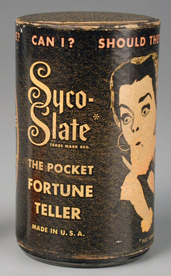 The Magic 8-Ball was inspired by fake seances. Mary Carter, a phony fortune teller, created a spirit writing device. Using a slate enclosed in a box, Carter could secretly write and pretend the spirits were communicating with the device. Her son, Alfred Carter, was amazed by the invention but wanted to make a device that required no skill to use.
The Magic 8-Ball was inspired by fake seances. Mary Carter, a phony fortune teller, created a spirit writing device. Using a slate enclosed in a box, Carter could secretly write and pretend the spirits were communicating with the device. Her son, Alfred Carter, was amazed by the invention but wanted to make a device that required no skill to use.
Alfred Carter created a device he called the Syco-Seer in 1944. The device was a tube divided in half. Each half was filled with a dark liquid and had a die with answers printed on each side. Each end of the tube would reveal different answers when asked a question.
Carter showed his idea to a local merchant in Cincinnati. The merchant wanted to sell the Syco-Seer in his store and distribute the product. Carter asked Abe Bookman, a relative for help with the creation and distribution of the product. They formed Alabe Crafts to produce and market the product. The product name was changed to Syco-Slate: The Pocket Fortune-Teller. In order to generate interest, women dressed like gypsies demonstrated the invention in department stores. Continue reading “The Syco-Seer”


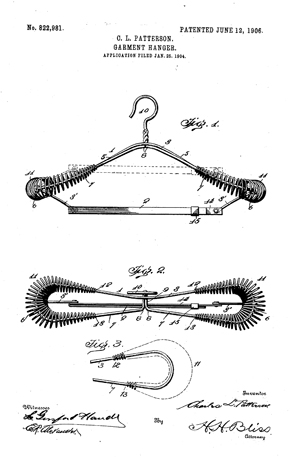 The coat hanger was invented in response to a lack of coat hooks in an office building in Jackson, Michigan in 1903. Albert J. Parkhouse worked for Timberlake Wire and Novelty Company which made lampshade frames and other wire items. One day, he arrived at work to discover that all the coat hooks were occupied. Parkhouse did not like having his winter coat getting wrinkled on the back of a chair all day. He decided to find a solution.
The coat hanger was invented in response to a lack of coat hooks in an office building in Jackson, Michigan in 1903. Albert J. Parkhouse worked for Timberlake Wire and Novelty Company which made lampshade frames and other wire items. One day, he arrived at work to discover that all the coat hooks were occupied. Parkhouse did not like having his winter coat getting wrinkled on the back of a chair all day. He decided to find a solution.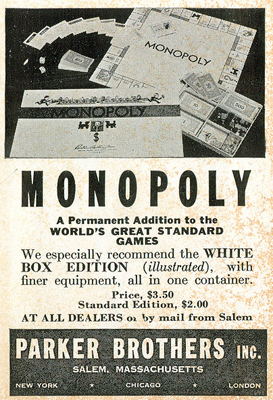 Charles Darrow, an unemployed man living in Germantown, Pennsylvania, created the board game Monopoly in the evenings while trying to make ends meet during the day. In the game, all players have the chance to buy and sell real estate. Living during the great depression, this board game gave the hard pressed workers of the time a chance for fantasy and distraction from their difficult lives.
Charles Darrow, an unemployed man living in Germantown, Pennsylvania, created the board game Monopoly in the evenings while trying to make ends meet during the day. In the game, all players have the chance to buy and sell real estate. Living during the great depression, this board game gave the hard pressed workers of the time a chance for fantasy and distraction from their difficult lives.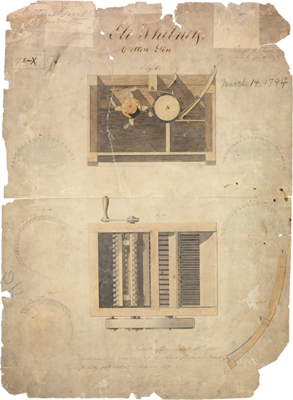 An invention can be so valuable as to be worthless to the inventor. Eli Whitney came to this conclusion because of the financial failure that was the cotton gin. Whitney gained fame and notoriety from his invention but did not gain the wealth he had anticipated.
An invention can be so valuable as to be worthless to the inventor. Eli Whitney came to this conclusion because of the financial failure that was the cotton gin. Whitney gained fame and notoriety from his invention but did not gain the wealth he had anticipated.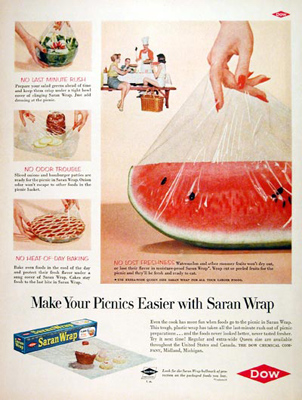 Saran wrap is another product which can be added to the list of accidental inventions. Ralph Wiley was not even working as a scientist when he discovered the substance that would become Saran wrap.
Saran wrap is another product which can be added to the list of accidental inventions. Ralph Wiley was not even working as a scientist when he discovered the substance that would become Saran wrap.